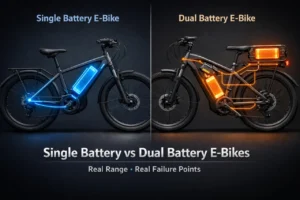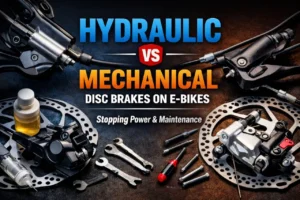
Single Battery vs Dual Battery E-Bikes: Range Truth + Failure Points
Single vs dual battery e-bikes isn’t just about miles. Learn real range expectations, weight trade-offs, and the failure points that affect ownership.
Learn is where we break down how e-bikes really work—from motors and batteries to safety, maintenance, and riding techniques. These guides are designed to help you understand the fundamentals, avoid common mistakes, and make smarter buying and riding decisions.

Single vs dual battery e-bikes isn’t just about miles. Learn real range expectations, weight trade-offs, and the failure points that affect ownership.

Hydraulic vs mechanical disc brakes on e-bikes: real stopping power, modulation, heat, wet performance, and maintenance—choose the right system.

Full suspension isn’t always better. Compare full suspension vs hardtail e-bikes for comfort, traction, range, weight, and maintenance—then choose confidently.

Suspension fork vs no suspension e-bike—this guide explains when suspension improves comfort and control, when it wastes energy, and who should skip it.

How to fix a flat tire on an electric bike, from powering down to reconnecting hub-motor wiring—plus bead seating, PSI tips, and flat prevention.

Step-through vs step-over isn’t about looks—it’s about daily confidence. Compare stability, fit, and cargo handling to choose the frame you won’t regret.

This tire pressure guide explains how to set e-bike tire pressure for your weight, terrain, and weather, with PSI ranges, tools, and quick check steps.

E-bike range often drops faster in cold weather. Learn how temperature, riding habits, and terrain affect battery life — and how to fix it.

Class 2 vs class 3 e-bikes, explained for USA riders: real speed benefits, safety trade-offs, legal reality, common mistakes, and a decision checklist.

Fat Tire vs Regular Tire: learn how tire width changes comfort, range, handling, and flats—plus simple rules to choose the right setup.

Hub motor vs mid-drive isn’t about hype—it’s about hills, heat, maintenance, and long-term cost. Here’s what you’ll feel in real riding, fast.

Torque sensor vs cadence sensor—what’s the real difference? Compare ride feel, hills, stop-and-go commuting, and range to choose the right assist style.

Learn how to read e-bike battery specs: Wh, volts, amps and C-rate—so you can cut through marketing claims, estimate real-world range and buy with confidence.

Left your e-bike in storage and now the battery won’t charge? This safety-first guide shows how to wake it up, stay fire-safe, and avoid dead packs next season.

Get your e-bike winter-ready with a 10-step checkup: battery care, tire grip, brake refresh, brighter lights, salt-proof cleaning, and range-saving tips.

Wondering if you can fly with an e-bike battery? We explain FAA limits, airline policies, packing steps, and smart alternatives like shipping or renting.

Learn how to store your e-bike battery for winter: ideal charge, safe storage, monthly checks, and a spring wake-up that protects range and extends life.

Confirm a UL-certified e-bike and battery—what labels to find, how to use UL Product iQ, NYC rules, red-flag checks, and step-by-step proof you can trust.
![[year] E-Bike Rebates & Incentives: US, Canada, UK & EU (Updated Guide) 2025 E-Bike Rebates Explained: Where to Apply and How to Max Your Savings](https://goebikelife.com/wp-content/uploads/2025/09/E-Bike-Rebates-Explained-300x200.jpg)
Cut the cost of a new e-bike with our 2025 rebates guide. See US, Canada, UK & EU programs, eligibility rules, deadlines, and smart ways to stack savings.

What UL 2849/2271 mean, how to verify claims on Amazon, and safer e-bike picks—plus charging, recall and recycling tips to ride smarter in 2025 worldwide.